
The Twilight Zone is an American media franchise based on the anthology television series created by Rod Serling in which characters find themselves dealing with often disturbing or unusual events, an experience described as entering "the Twilight Zone". The episodes are in various genres, including fantasy, science fiction, absurdism, dystopian fiction, suspense, horror, supernatural drama, black comedy, and psychological thriller, frequently concluding with a macabre or unexpected twist, and usually with a moral. A popular and critical success, it introduced many Americans to common science fiction and fantasy tropes. The first series, shot entirely in black-and-white, ran on CBS for five seasons from 1959 to 1964.
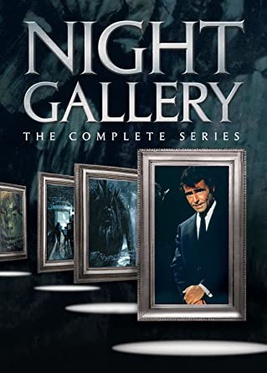
Night Gallery is an American anthology television series that aired on NBC from December 16, 1970, to May 27, 1973, featuring stories of horror and the macabre. Rod Serling, who had gained fame from an earlier series, The Twilight Zone, served both as the on-air host of Night Gallery and as a major contributor of scripts, although he did not have the same control of content and tone as he had on The Twilight Zone. Serling viewed Night Gallery as a logical extension of The Twilight Zone, but while both series shared an interest in thought-provoking dark fantasy, more of Zone's offerings were science fiction while Night Gallery focused on horrors of the supernatural.
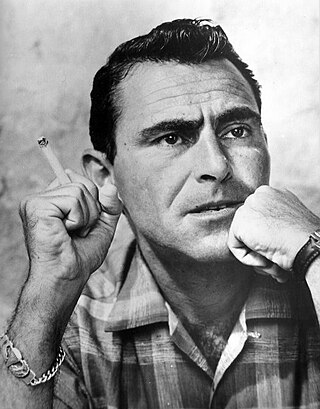
Rodman Edward Serling was an American screenwriter and television producer best known for his live television dramas of the 1950s and his anthology television series The Twilight Zone. Serling was active in politics, both on and off the screen, and helped form television industry standards. He was known as the "angry young man" of Hollywood, clashing with television executives and sponsors over a wide range of issues, including censorship, racism, and war.
"The Purple Testament" is the nineteenth episode of the American television anthology series The Twilight Zone. It is "the story of a man who can forecast death". It originally aired on February 12, 1960, on CBS.

Richard Lewis Deacon was an American television and motion picture actor, best known for playing supporting roles in television shows such as The Dick Van Dyke Show, Leave It to Beaver, and The Jack Benny Program, along with minor roles in films such as Invasion of the Body Snatchers (1956) and Alfred Hitchcock's The Birds (1963).

Playhouse 90 is an American television anthology drama series that aired on CBS from 1956 to 1960 for a total of 133 episodes. The show was produced at CBS Television City in Los Angeles, California. Since live anthology drama series of the mid-1950s usually were hour-long shows, the title highlighted the network's intention to present something unusual: a weekly series of hour-and-a-half-long dramas rather than 60-minute plays.

The Twilight Zone is an American science fiction horror anthology television series created and presented by Rod Serling, which ran for five seasons on CBS from October 2, 1959, to June 19, 1964. Each episode presents a standalone story in which characters find themselves dealing with often disturbing or unusual events, an experience described as entering "the Twilight Zone", often with a surprise ending and a moral. Although predominantly science-fiction, the show's paranormal and Kafkaesque events leaned the show towards fantasy and horror. The phrase "twilight zone", inspired by the series, is used to describe surreal experiences.
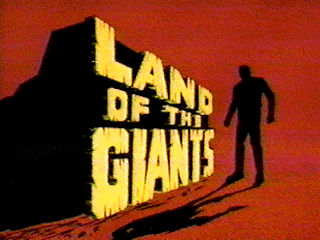
Land of the Giants is a one-hour American science fiction television series that aired on ABC for two seasons, beginning on September 22, 1968, and ending on March 22, 1970. The show was created and produced by Irwin Allen. Land of the Giants was Allen's fourth science-fiction TV series. The show was released by 20th Century Fox Television. The series was filmed entirely in color and ran for 51 episodes. The show starred Gary Conway and special guest star Kurt Kasznar.
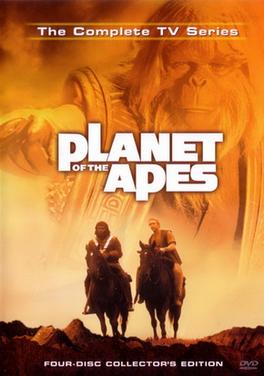
Planet of the Apes is a 1974 American science fiction television series that was broadcast on CBS. The series features Roddy McDowall, Ron Harper, James Naughton, and Mark Lenard. It is based on the 1968 film of the same name and its sequels, which were, in turn, based on the 1963 novel Planet of the Apes by Pierre Boulle.

Shannon Rutherford is a fictional character played by Maggie Grace on the ABC drama television series Lost, which chronicled the lives of the survivors of a plane crash in the South Pacific. Shannon was introduced in the pilot episode as the stepsister of fellow crash survivor Boone Carlyle. She was a series regular until her funeral in "What Kate Did". For most of her time on the Island, she was unhelpful and spent much of her time sunbathing. She formed a relationship with another survivor from the plane crash, Sayid Jarrah. Shannon was accidentally shot and killed by Ana Lucia Cortez, who mistakes her for an Other.

Walter "Walt" Lloyd is a fictional character portrayed by Malcolm David Kelley in the American ABC television series Lost. The series follows the lives of over forty survivors of the crash of Oceanic Flight 815. Walt is introduced in the pilot episode as one of the survivors aboard the plane, which crashes onto the island where most of the program takes place. He is the 10-year-old son of Michael Dawson.

Boone Carlyle is a fictional character who was played by Ian Somerhalder on the ABC drama television series Lost, which chronicles the lives of the survivors of a plane crash in the south Pacific. Boone is introduced in the pilot episode as the stepbrother of fellow crash survivor Shannon Rutherford. He tries to contribute as much as he can to the safety of the castaways and eventually becomes John Locke's protégé.

Flight 29 Down is an American adventure comedy-drama television series about a group of teenagers who are stranded on an island. It was produced by Discovery Kids. The show was created by Stan Rogow and D. J. MacHale. The executive producers are Rogow, MacHale, Shauna Shapiro Jackson, and Gina & Rann Watumull.

"Pilot" is the two-part television pilot of the ABC television series Lost, with part 1 premiering on September 22, 2004, and part 2 one week later on September 29. Both parts were directed by J. J. Abrams, who co-wrote the script with series co-creator Damon Lindelof. Jeffrey Lieber, who had been commissioned by ABC to write the first version of the script, earned a story credit. Filmed in Oahu, Hawaii, it was the most expensive pilot episode up to that time, costing between $10 and $14 million, largely due to the expense of purchasing, shipping, and dressing a decommissioned Lockheed 1011 to represent Flight 815's wreckage. Many changes were made during the casting process, including the selected actors, the characters' behaviors and fates.
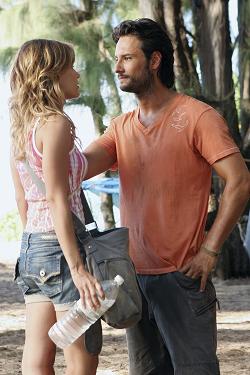
Nikki Fernandez and Paulo are fictional characters on the ABC drama television series Lost, which chronicles the lives of over forty people after their plane crashes on a remote island somewhere in the South Pacific. American actress Kiele Sanchez and Brazilian actor Rodrigo Santoro play two survivors of the crash of Oceanic Flight 815.

Lost is an American science fiction adventure drama television series created by Jeffrey Lieber, J. J. Abrams, and Damon Lindelof that aired on ABC from September 22, 2004, to May 23, 2010, over six seasons and 121 episodes. It contains elements of supernatural fiction, and follows the survivors of a commercial jet airliner flying between Sydney and Los Angeles, after the plane crashes on a mysterious island somewhere in the South Pacific Ocean. Episodes typically feature a primary storyline set on the island, augmented by flashback or flashforward sequences which provide additional insight into the involved characters.

Frank J. Lapidus is a fictional character on the ABC television series Lost played by Jeff Fahey. Frank is introduced in the second episode of season four as a pilot hired on a mission to the island where Oceanic Flight 815 crashed. He aids the survivors of the crash against mercenary Martin Keamy and helps to rescue a group who become known as the Oceanic Six. Three years later, Frank encounters the group again while working as a commercial airline pilot. His plane lands back on the island, and he is forcibly taken in by a group of his passengers headed by Ilana and Bram, who are working for the island's highest authority figure Jacob. In the series finale, he ultimately escapes the island with a few of his fellow inhabitants.

"Forbidden Area" was an American television play broadcast live on October 4, 1956, as part of the CBS television series, Playhouse 90. It was the premiere episode of the series. The play concerns efforts to thwart a massive, Christmastime nuclear attack from a fleet of Russian submarines located off the coast of the United States. Rod Serling wrote the screenplay, and John Frankenheimer directed. Charlton Heston, Tab Hunter, Diana Lynn, and Charles Bickford starred.
Aviation accidents and incidents, particularly civilian airplane crashes or incidents threatening a crash or requiring an emergency landing, are a common theme in fiction. Films centered on such incidents make up a substantial subset of the disaster film genre, and influence how other stories within the genre are told. Works in this genre encompass both fictional depictions of the incidents themselves, and depictions of consequences such as investigations, lawsuits, and the effect on the lives of persons involved. A subgenre, the "plane crash survival movie", involves characters placed in a dangerous environment by an initial airplane crash. Airplane crashes have been described as "the easy and obvious device" for dramatically incorporating an airplane into the plot of a film, and as "a Hollywood staple", with various levels of praise or criticism directed to the realism of specific depictions.













